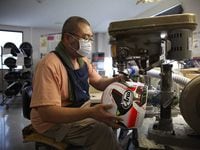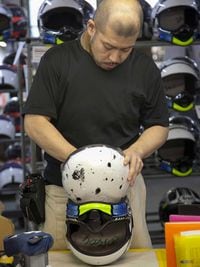Each day in Omiya and Shinto, Japan, hundreds of workers assemble in the Arai Helmets factory with one common goal: to construct motorcycle helmets that provide the highest possibility of protection.
"We aren't smart business people," shares Michio "Mitch" Arai, who runs the company originated in 1926 by his father Hirotake Arai. He's referring to the fact that Arai invests heavily in higher standards of protection than required by Snell M2020 because in a factory where most employees and their families are motorcyclists, their own desire to protect and in-house standards are much more stringent. The added manufacturing costs may not make Arai smart businessmen, but absolutely great helmet makers. And with these family values, relentless work ethics, and refusal to make compromises in quality and protection, Arai Helmets presents the new Regent-X, a helmet built with the same protection as its flagship Corsair-X model, with a newly designed interior for comfort and ease of removal.
Born from Arai’s exclusive F1 helmet technology and using newly developed Peripheral Belted Complex Laminate Construction 1 (PBcLc1), the Regent-X was designed with a lighter and stronger shell. In order to add shell strength without increasing thickness or weight, proprietary super fibers are woven together to form the Peripheral Belt, which reinforces the upper edge of the helmet’s eyeport. Arai has also expanded the Hyper-Ridge at the chin and cheek area by 5mm, which doesn’t seem like much, but effectively makes it much easier to get on and off. The Regent-X’s liner and cheek pads are made from soft brushed nylon fabric—quite comfortable, even on long rides; we rode approximately 400 miles around Japan wearing the new Arai Regent-X.
The Regent-X is positioned and priced as an entry-level Arai helmet made with the exact same diligence and protective inner workings of the brand’s top-level helmets. Priced at $559.95, it’s an extremely comfortable, well-designed helmet available for substantially less than Arai’s current flagship model, the Corsair-X at $1,059.59.
So how does Arai hand-build nearly 250,000 helmets a year and ensure that each one represents maximum quality and protection? As guests of Mr. Arai, we visited all of the Arai Helmets’ production facilities in both Omiya and Shinto, Japan—including two buildings never toured by journalists before—to witness the entire process firsthand.
And after extensive observation of the entire process, it’s quite clear the factory machines do not make these helmets—the people who operate the machines make them. Experts, true craftsmen, loyal Arai employees who have developed highly specialized skills using equipment sensitive to variables like humidity, temperature, and contaminations are the real credit to the creation of some of the most protective motorcycle helmets in the industry.
Related: Arai Classic-V Helmet Review
Every Arai Helmet is hand-built and begins as what they call a “nest,” where fiberglass or super fiber is blown into large bowls and shaped around unique forms, based on helmet model and size. Ultimately, a small group of “Shell Experts,” an elite team of shell makers, carefully hand lay more than 20 separate materials as they create the Arai shell.
Each fiberglass nest is then placed into a unique mold, based on helmet model and size, before a proprietary blended resin is added to solidify the primary shell using heat and pressure. These molds are used continuously for several years before the tools used for scraping away unwanted resins begins to scrape away a layer of the core mold, potentially affecting the desired dimensions of the mold.
One of the only robotic mechanisms of the helmet-making process takes place quite early in the shell fabrication program—a robotic guided laser is used to precisely cut in the eyeports and navigate the outer shell edge. Unwanted materials in the initial form-making process, such as staples used to hold multiple layers together, are intentionally located in the eyeports so that they are removed from the shell when they reach this stage.
Every helmet shell goes through two rigorous inspections using scales, micrometers, and the keen eyes of the Arai Shell Experts in order to ensure that every shell meets prescribed thickness, weight, and structural integrity. If the thickness is very close, the Shell Expert may apply small patchwork so that the helmet will meet the desired thickness and not to waste a potentially good shell. Each acceptable helmet shell is then signed by the approving Shell Expert, adding to the accountability of the inspection. Arai employees take great pride in removing unbalanced or rejected shells from advancing to other departments.
Approved shells have very rough surfaces and must be hand buffed with a special compound that is used to fill in tiny pores on the exterior of the shell in order to create a smooth surface for painting.
The painting process takes each shell through a dozen steps of priming, baking, wet sanding, and another round of inspections before the final graphic decals or paint is applied. These steps can take several days as the shells with coats of primer need to cure in drying kilns before being taken back through additional wet sanding to ensure the final smooth surface. A second inspection takes place after the second coat of primer to guarantee a flawless finish before the shell goes to paint.
Helmet shells that pass final primer inspections are moved to the paint department and receive their first coat of paint by hand. Each helmet color takes three days—one to mask, one to paint and sand, and one for graphics. Newly painted and decaled Arai helmets cure on racks in drying rooms or kilns as they await final clear coats to be applied. Helmet shells can remain in the painting department up to one week before moving forward.
After the painting is completed, any holes are drilled into the helmet to provide access for rivets, chinstraps, small breath guards, and rubber trim that are mounted to the shell. Trained technicians replace drill bits every 80 helmets to ensure precise cutting. Interior vent channels are applied to the shell’s eyeports to help prevent shield fogging, a design feature that was initially developed for MotoGP.
Because alignment in the helmet is critical, only five Arai employees are certified to install the EPS liners into the helmets. To ensure alignment with the vent holes, each liner much be installed perfectly in the first or second attempt. In the event of two failed installation attempts, the liner is disposed of.
Once the EPS liners are installed, breakaway vent scoops are installed using high-tension adhesives; these scoops are designed to break away in the event of a crash, maximizing the glancing-off capabilities of the helmet. Next, shield systems are installed and hand tested for perfect fit and to prevent unwanted debris, air, or moisture passing through.
Every helmet undergoes one final inspection, a long checklist, before the helmet is labeled bagged, and boxed up for shipping. The final inspection process is just as critical as the first inspection of the fiber nests. Arai employees take great pride in their work to ensure the safety of those who will wear their handmade protective products.
After visiting Arai’s production facilities in Omiya and Shinto, we put the new Regent-X to the full test—we rode a variety of motorcycles, lent to us by Honda Motorcycles Japan, hundreds of miles over mountainous roads to the prefectures of Gunma and Tochigi to take in some of the sights and sounds of the Japanese countryside. Over a few days, we subjected the helmets to almost every possible condition along highways, through tunnels, and over twisty mountain roads: heat, humidity, darkness, glare, rain—and by rain, we rode several hours through the remnants of a Category 1 typhoon.
While my boots, sleeves and pants filled with tropical storm rain literally coming from the ground upward, it was ultimately my new Regent-X helmet that was the only piece of equipment that remained dry inside and provided me with a clear and safe passage. The Arai Regent-X proved to be an extremely comfortable helmet with great visibility and protection from the elements—a helmet that I’ll regularly wear with pride and confidence.
























/cloudfront-us-east-1.images.arcpublishing.com/octane/VZZXJQ6U3FESFPZCBVXKFSUG4A.jpg)
/cloudfront-us-east-1.images.arcpublishing.com/octane/QCZEPHQAMRHZPLHTDJBIJVWL3M.jpg)
/cloudfront-us-east-1.images.arcpublishing.com/octane/HXOUJXQWA5HBHGRO3EMJIGFMVI.jpg)

/cloudfront-us-east-1.images.arcpublishing.com/octane/3TIWWRV4JBBOLDVGRYECVVTA7Y.jpg)
/cloudfront-us-east-1.images.arcpublishing.com/octane/KIX5O23D5NAIBGFXBN3327DKZU.jpg)
/cloudfront-us-east-1.images.arcpublishing.com/octane/7GJYDUIPXRGMTMQKN6ONYOLBOU.jpg)
/cloudfront-us-east-1.images.arcpublishing.com/octane/MUQLOVLL2ZDGFH25ILABNBXKTI.jpg)
/cloudfront-us-east-1.images.arcpublishing.com/octane/TNOU5DNE2BC57MFPMGN2EIDXAM.jpg)
/cloudfront-us-east-1.images.arcpublishing.com/octane/GTCXACQGJ5HAPDTGWUQKDEH44E.jpg)
/cloudfront-us-east-1.images.arcpublishing.com/octane/S35YGSEMEZB4BLTDJTSZPF4GLA.jpg)
/cloudfront-us-east-1.images.arcpublishing.com/octane/5UOT6HPX2JFMRJAX6EH45AR4MQ.jpg)
/cloudfront-us-east-1.images.arcpublishing.com/octane/OKWOJWAKP5EP3OACCRRWPCIX2Q.jpg)
/cloudfront-us-east-1.images.arcpublishing.com/octane/2WF3SCE3NFBQXLDNJM7KMXA45E.jpg)
/cloudfront-us-east-1.images.arcpublishing.com/octane/G4MG6OUCJNBSHIS2MVVOTPX65E.jpg)
/cloudfront-us-east-1.images.arcpublishing.com/octane/IIGGWFOTOJGB7DB6DGBXCCMTDY.jpg)
/cloudfront-us-east-1.images.arcpublishing.com/octane/QSTCM6AVEZA5JJBUXNIQ3DSOF4.jpg)
/cloudfront-us-east-1.images.arcpublishing.com/octane/U4I7G625B5DMLF2DVIJDFZVV6M.jpg)
/cloudfront-us-east-1.images.arcpublishing.com/octane/B6XD6LS6IVCQPIU6HXDJSM3FHY.jpg)
/cloudfront-us-east-1.images.arcpublishing.com/octane/ICL63FEDDRDTTMINYICCEYGMDA.jpg)
/cloudfront-us-east-1.images.arcpublishing.com/octane/FCGZHQXRBZFLBAPC5SDIQLVF4I.jpg)
/cloudfront-us-east-1.images.arcpublishing.com/octane/WNOB6LDOIFFHJKPSVIWDYUGOPM.jpg)

/cloudfront-us-east-1.images.arcpublishing.com/octane/X33NU3E525ECRHXLNUJN2FTRKI.jpg)